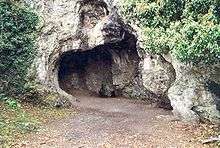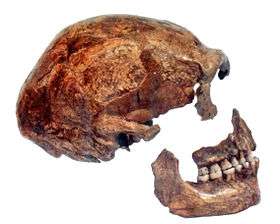Spy Cave

Spy Cave (Grotte de Spy in French) is located near Spy in the municipality of Jemeppe-sur-Sambre, province of Namur, Belgium above the left bank of the Orneau River.[1] It has been classified as Wallonia's Major Heritage by the Walloon Region. It is one of the most important paleolithic sites in Europe. The cave has small chambers and corridors.[2]

Excavations
Since the first amateur excavations in the late 19th century numerous amateur and professional archaeologists have carried out excavations removing all the deposits from the cave. In 1886 a discovery was made that still represents a major episode in the history of science. The excavation was conducted by inhabitants of Liège, and consisted of the archaeologist Marcel de Puydt and geologist Max Lohest. This team proved to the international community the existence of a more antiquated type of human, the Neanderthal. Julien Fraipont, a paleontologist and zoologist, published a review in the American Anthropologist.[3]
The assemblages from the oldest excavations appear to have been mixed, making interpretation of the palaeoenvironmental data difficult.[4] In addition papers by de Puydt, Lohest and Fraipoint disagree on the number of layers of knapped flints. Nonetheless, it is thought that there were seven, possibly more, Paleolithic occupations, three Mousterian and four Upper Paleolithic.[5]
The hominid skeletons discovered in the first excavations have been named Spy I, a female, and Spy 2, a young male. These have now been dated to around 3600BP.[4][6] The identification of the remains of another Neanderthal, a young child known as Spy VI, were published in a 2010 paper. The identification was made from an analysis of the mandibular remains and the child is thought to have died at about 18 months, "making the Spy Neandertal remains the youngest ever directly dated in northwest Europe."[7] It is probable that these skeletons were deliberately buried.[8]
Almost 12,000 bones from the Pleistocene were found, including mammoth, horse, cave hyena, woolly rhinoceros reindeer and cave bear bones.[2]
Mammoth hunting
All levels contained mammoth remains, including an unusual (compared to other sites) number of molars. It has been suggested that the Neanderthal occupants brought mammoth heads to the site and ate the brains. Because many of the molars were unworn, these would have been very young or newborn calves, "killed in early spring, when plant food would not yet have been available."[9]
Anatomically modern humans
Evidence of occupation by Upper Paleolithic anatomically modern humans has also been found at Spy. A report published in 2013 states that "Based on cut-marked bones, remains with ochre traces and an Aurignacian spear point, it seems that AMH visited Spy at least three times: at around 34,500 BP, 33,000 BP and 26,000 BP."[10] Pendants and perforated beads made from mammoth ivory, presumably by modern humans, were found in the cave.[11]
References
- ↑ "Accéder". La grotte de Spy: le sommaire (in French). Retrieved 2007-03-15.
- 1 2 Camille Daujeard, Grégory Abrams, Mietje Germonpré, Jeanne-Marie Le Pape, Alicia Wampach, Kevin Di Modica, Marie-Hélène Moncel "Neanderthal and animal karstic occupations from southern Belgium and south-eastern France: Regional or common features?", Quaternary International Available online 27 May 2016, doi:10.1016/j.quaint.2016.02.009.
- ↑ La race humaine de Neanderthal ou de Canstadt en Belgique: Recherches ethnographiques sur des ossements d'une grotte à Spy et détermination de leur âge géologique in American Anthropologist, Vol. 1, No. 3 (Jul., 1888), pp. 286-287 (review consists of 2 pages).
- 1 2 Stéphane Pirson, Damien Flas, Grégory Abrams, Dominique Bonjean, Mona Court-Picon, Kévin Di Modica, Christelle Draily, Freddy Damblon, Paul Haesaerts, Rebecca Miller, Hélène Rougier, Michel Toussaint, Patrick Semal, "Chronostratigraphic context of the Middle to Upper Palaeolithic transition: Recent data from Belgium", Quaternary International 259:78-94 · May 2012, pp.78-94
- ↑ Toussaint, Michel; Pirson, Stéphane (2006). "Neandertal Studies in Belgium: 2000–2005". Periodicum Biologorum. 108 (3): 373–387. ISSN 0031-5362.
- ↑ Semal P, Rougier H, Crevecoeur I, Jungels C, Flas D, Hauzeur A, Maureille B, Germonpré M, Bocherens H, Pirson S, Cammaert L, De Clerck N, Hambucken A, Higham T, Toussaint M, van der Plicht J.(April 2009). "New data on the late Neandertals: direct dating of the Belgian Spy fossils", American Journal of Physical Anthropology, 138 (4): 421–8. doi:10.1002/ajpa.20954
- ↑ Crevecoeur I, Bayle P, Rougier H, Maureille B, Higham T, van der Plicht J, et al. "The Spy VI child: A newly discovered Neandertal infant", Journal of Human Evolution, 2010;59: 641–656. doi: 10.1016/j.jhevol.2010.07.022
- ↑ Semal, P, Hauzeur, A, Rougier, H, Crevecoeur, I, Germonpré, M, Pirson, S, Haesaerts, P, Jungels, C, Flas, D, Toussaint, M, Maureille, B, Bocherens, H, Higham, T, van der Plicht, J, "Radiocarbon Dating Of Human Remains And Associated Archaeological Material", Anthropologica et Præhistorica, Vol. 123, 2012, pp.331-356
- ↑ Germonpré, Mietje; Udrescu, Mircea; Fiers, Evelyne (2013). "Possible evidence of mammoth hunting at the Neanderthal site of Spy (Belgium)" (PDF). Quaternary International. 337: 28–42.
- ↑ Germonpré, Mietje; Udrescu, Mircea; Fiers, Evelyne (2013). "The Fossil Mammals Of Spy" (PDF). Anthropologica et Præhistorica. 123: 289–327. Retrieved 4 August 2016.
- ↑ Crow, T. J. (2004). The Speciation of Modern Homo Sapiens. Oxford University Press. p. 33. ISBN 978-0197263112. Retrieved 4 August 2016.
External links
-
 Media related to Spy Cave at Wikimedia Commons
Media related to Spy Cave at Wikimedia Commons
Coordinates: 50°28′57″N 4°40′09″E / 50.4824°N 4.6691°E